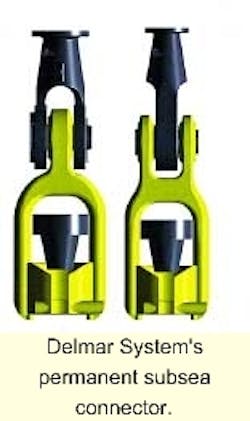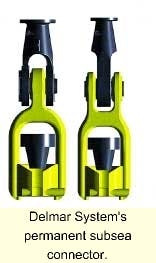ROV-actuated disconnect device ready for mooring
Delmar System's permanent subsea connector.
A disconnectable, permanent subsea connector aimed at connecting mooring lines to subsea anchors has been developed by Delmar Systems. The open-throated design consists of male and female components that can be connected and disconnected via any 100 hp remotely operated vehicle (ROV) without the need for specific tools.
This was the first classification society-approved ROV actuated disconnectable device for use in mooring systems in the MODU market, according to Delmar Executive Vice-President Brady Como. This means the anchors can be deployed from one vessel and the mooring line attachment completed at the convenience of the operator. "The connector concept originated with the need to permit a single vessel/single line installation of suction anchors, something that previously was conducted with two vessels due to the inability to connect to the anchor subsea." said Como.
Initially, the connector was designed for temporary mooring installations, but modifications allow the connector to be used with the style of fittings and mooring components used in permanent mooring systems. This new connector gives operators the option of using fewer connections while maintaining the ability to connect and disconnect the mooring leg from the anchor foundation.
"This connector adds a new dimension, enabling operators to change out mooring components using a standard anchor-handling vessel (AHV) without having to unseat the anchor." Como said. The connector is designed for use with any type of anchor foundation, mooring line, chain, wire, or synthetic in any water depth. The male portion of the connector can be modified for chain or wire connections. The female connections can be adapted for shackles, connecting link, or spelter socket connection.
The connector is designed in several sizes to accommodate different mooring loads, can reduce the number of connectors needed in a mooring system, and is available freestanding or integrated.
Riser works with dual density drilling
While three different approaches to dual-density drilling continue to develop, Stewart & Stevenson has independently developed a riser system that will work with any of them. All three of the alternatives under development share the common element of requiring a mud return line to carry the diverted fluid back to the rig floor. Stewart & Stevenson has integrated such a line into their new riser design.
The Dual Gradient Drilling Mud Return Marine Riser System (DMRStrademark) has a large diameter 7.4-in. ID mud return line and a riser isolation tool (SSIT) that can be run from the surface inside the riser, and landed just above the BOP stack. International Operations Manager Louis Slaughter (Stewart & Stevenson) said the isolation tool can be run in with the bottomhole assembly and locked in place. When the tool shears out, the driller can continue drilling with the isolation tool engaged, diverting the fluid returns at the top of the BOP stack into whichever artificial mud lift system is used.
The DMRS is designed to operate in either the dual gradient or conventional mode so that zones with narrow margins can be drilled "riserless" and the rest of the well can be drilled conventionally, through valves that allow returns to bypass the diverter and flow up the riser.
In addition to the riser design, Stewart & Stevenson also is working on a variety of artificial mudlift solutions, including nitrogen injection and blending microspheres into the mud returns. These spheres would lower the weight of the fluid returns, assisting them in moving up to the rig floor. Once topside, the spheres would be separated from the flow and recycled into the system.
This riser system can be used with a conventional 18-in. BOP stack in deepwater operations. The isolation tool is an option, but a user will be able to drill conventionally while retaining the option to introduce dual gradient drilling.
Slaughter said his company has already talked with major operators about their needs concerning the dual gradient system. The response has been that, regardless of which system is used, an integrated riser coupling will be needed to get the diverted returns to the surface. "Once the concept of subsea pumping is proven, they will need a riser with the mud return lines and an isolation tool to divert the fluid at the stack. That's what we're offering," Slaughter said.
While the addition of a 7.4-in. line to the riser string will increase the overall weight of the string, Slaughter said the use of composite materials in this line, as well as the choke and kill lines, will compensate for the additional weight.
Vastar taps Aker for risers
Operator Vastar Resources has awarded Aker Maritime a contract for delivery of a top-tensioned riser system, to go along with Aker's Spar hull to be used in development of the Horn Mountain field on Mississippi Canyon Block 127 in the Gulf of Mexico.
Under the contract, Aker Maritime will be responsible for the engineering, procurement, fabrication, and delivery of eight top-tensioned risers, with options for up to six additional risers. The contract follows one let earlier this summer in which Aker was selected to perform the engineering, procurement, fabrication, and delivery of a complete Spar hull and mooring system for the Horn Mountain development. Delivery of the Spar is scheduled for the second quarter of 2002.
Vastar is the operator on the field and holds a two-thirds working interest in Horn Mountain. Occidental Petroleum holds the remaining one-third interest. Horn Mountain is located in 5,400-ft water depths, meaning the development will represent a new water depth record for a floating production system. Daily production from the field is anticipated to peak at 65,000 b/d of oil and 60 mcf of gas.
Norsk Hydro wins innovation award
Chosen from a short list of eight new, innovative technologies, Norsk Hydro's H-Sep downhole horizontal separation system won the annual Offshore Northern Seas award for innovation at the recent conference in Stavanger, Norway. H-Sep is a process for separating the wellstream fluids downhole. Norsk and its partners Weir Pumps and Kvaerner developed the process. It has received a patent and a pilot test is scheduled of the Brage platform in the North Sea.
Aker Maritime takes over yard
The Aker Gulf Marine yard in Texas has proven to be a strategic launching pad for many of the latest deepwater projects. High profile projects, such as the Bald Pate compliant tower, Genesis spar, and Discoverer Spirit drillship left land from this fabrication yard. Recognizing the value of this yard Aker Maritime recently decided to buy out its partner, Peter Kiewit Sons' Inc. While the announcement of this decision came close to press time, Aker said the actual take-over of the yard will occur in the late fall as soon as the transaction is approved by the US authorities.




